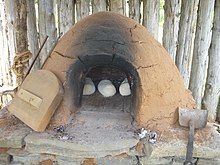It has been suggested that Tabun oven be merged into this article. (Discuss) Proposed since September 2024. |

The primitive clay oven, or earthen oven / cob oven, has been used since ancient times by diverse cultures and societies, primarily for, but not exclusive to, baking before the invention of cast-iron stoves, and gas and electric ovens. The general build and shape of clay ovens were, mostly, common to all peoples, with only slight variations in size[1] and in materials used to construct the oven. In primitive courtyards and farmhouses, earthen ovens were built on the ground.[1]
In Arabian, Middle Eastern and North African societies, bread was often baked within a clay oven called in some Arabic dialects a tabun (also transliterated taboon, from the Arabic: طابون),[2] or else in a clay oven called a tannour, and in other dialects mas'ad. The clay oven, synonymous with the Hebrew word tannour, lit. 'oven', was shaped like a truncated cone, with an opening either at the top or bottom from which to stoke the fire. Others were made cylindrical with an opening at the top. Built and used in ancient times as the family, neighbourhood, or village oven, clay ovens continue to be made in parts of the Middle East today.[3]
- ^ a b Maimonides (1967), p. 46 (Seder Taharot), s.v. Keilim 5:1.
- ^ The word exists in Arabic, from the root "طبن", Edward William Lane, An Arabic-English Lexicon, s.v. طبن, which according to its source means "He covered the fire [in a hollow] in the earth, in order that it might not become extinguished."
- ^ Negev and Gibson (2001), pp. 91-92.